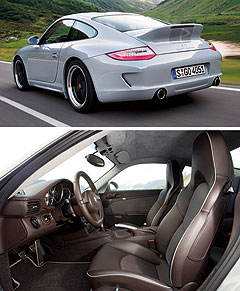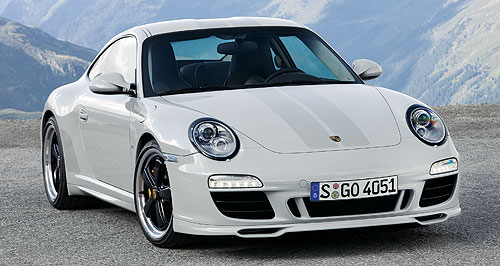Make / Model Search
Future models - Porsche - 911 - Sport ClassicFirst look: Porsche creates an instant 911 ‘Classic’Back to basics: The new Porsche 911 Sport Classic takes its cues from Porsches of the 1970s. Porsche shows off its super-exclusive, retro 911 Sport Classic, with 'ducktail'4 Sep 2009 By TERRY MARTIN PORSCHE has this week vowed to return to a tradition of exclusive limited edition models, heralding the launch of an ultra-exclusive and nostalgic 911 Sport Classic ahead of its world premiere at the Frankfurt motor show on September 15 – and its ultimate arrival in Australia, with a handful on offer, in the first quarter of 2010. Australian pricing is still to be determined for the Classic, but Porsche Cars Australia has confirmed that it will be one of the most exclusive non-turbocharged 911s ever to be sold here, which could therefore see it hit $350,000 or higher – clear of the circa-$330,000 GT3 RS with which it will share the limelight, along with the 911 Turbo Coupe and Cabriolet, at Frankfurt. As speculative reports out of Europe this week have thrown doubt over the long-term future of new-segment Porsche models under Volkswagen ownership, including the Panamera GT currently on an around-Australia launch tour, Porsche has taken an emotive turn back to the less complicated 1970s with the 911 Sport Classic. Limited to a production run of just 250 units, and under development at the Porsche Exclusive specialist vehicle unit for the past three years, the Sport Classic has emerged featuring the ‘ducktail’ rear spoiler made famous by the 1973 Carrera RS 2.7 and with ‘Fuchs-style’ custom-made alloy wheels from the same era.  But this is much more than a 911 Carrera S with a retro rear spoiler and some new rims. But this is much more than a 911 Carrera S with a retro rear spoiler and some new rims.There are also further unique front and rear design treatments, a new double-dome roof (another reference to classic racing cars, as well as the recent Carrera GT), new side sills, redesigned front and rear lights which aim to illustrate the high technical standard of the “project” – and a more powerful version of the Carrera S’s direct-injection 3.8-litre boxer-six engine. In this case, the engine churns out 300kW of power at 7300rpm (up 17kW) and an unchanged 420Nm of torque – available from 4200-5600rpm – and drives the rear wheels through a six-speed manual gearbox (with shorter shift travel). All-wheel drive and the PDK are not available. According to Porsche, modifications to the intake manifold have allowed for an increase in engine output and torque, particularly in the medium speed range. Other upgrades include modified cylinder heads and a new engine management system, and the introduction of a variable-resonance intake system which features half a dozen vacuum-controlled flaps that switch between “a more power- and a more torque-oriented geometry”. “Opening or closing simultaneously as a function of engine speed and the position of the throttle pedal, these flaps optimise the oscillation of air in the intake manifold for a better cylinder charge,” Porsche explains. “The result is an optimum supply of fresh air into the combustion chambers under all conditions, maintaining maximum torque and optimising the torque curve – together with an increase in engine output.” There is also a unique exhaust system for the Sport Classic, providing the perfect exhaust gas counter-pressure, according to Porsche, and high-gloss tailpipes with classic grid inserts. In terms of outright acceleration, Porsche claims the Sport Classic can reach 100km/h from standstill in 4.6 seconds – a tenth quicker than the Carrera S manual – and 200km/h in 14.8 seconds. It has the same maximum speed of 302km/h and returns an identical 10.6L/100km on the combined European NEDC standard. Incremental performance gains and evocative detailing are seen elsewhere on the super-exclusive coupe, such as the carbon-fibre air filter housing on top of the engine. Sport Chrono Package Plus launch control is fitted standard, along with the ‘special variant’ of the Porsche Active Suspension Management (PASM) sports suspension which reduces ride height 20mm and adds a rear limited-slip differential. Lightweight, 350mm-diameter Porsche Ceramic Composite Brakes (PCCB), using carbon-fibre reinforced ceramics, are also included, along with six-piston aluminium monobloc brake callipers up front and four-piston grippers at the rear. The 19-inch wheels, complete with a high-gloss black paint finish on the rim centre, are a throwback to the classic Porsche-designed Fuchs rims first seen in the 1960s and come with the largest wheel dimensions on all non-GT 911s: 8.5J x 19 with 235/35 ZR19 tyres at the front, and 11J x 19 on 305/30 Z-rated rubber at the rear. The exterior paintwork is restricted to the bespoke Sport Classic Grey with half-hearted (Porsche prefers “discreet”) racing stripes, while the bi-Xenon headlights with dynamic cornering lights come with black surrounds – a nod to the 1974 911 Turbo RSR, among others. The air intake grilles are also finished in black, as are the mirror triangles and the lower sections of the mirror base. Porsche has used the rear bodywork from 911 Carrera 4S all-wheel drive models on the Sport Classic, which broadens the backside 44mm and allows the rear track to increase 34mm (to 1550mm). The doors are made from aluminium, which along with PCCB and other technologies, helps to offset the extra weight of the additional standard equipment on the Classic, which tips the scales at 1425kg – the same as the standard Carrera S. Other notable design features include a purpose-built spoiler lip on the front panel, providing aerodynamic balance with the rear spoiler, and a unique rear panel “inspired by the particularly sporting design of the GT cars” and clear-lens rear light clusters. The cabin is swathed in Espresso Nature leather trim and sees the debut of two new materials for Porsche – ‘woven’ leather (used as inserts on the adaptive sports seats and in the door linings) and an ultra-high-grade carpet. Leather extends as far as the air vent louvres and ignition barrel, while the unique instrument cluster includes black dials with a ‘911 Sport Classic’ marker. The three-spoke steering wheel has hand-sewn seams criss-crossing in contrasting colours, the seatbelts are finished in silver/grey and the headlining in light-grey Alcantara. A 385-watt Bose surround-sound stereo, developed for Porsche and tailored to the acoustic conditions within the 911, includes 13 speakers (including an active subwoofer) and a seven-channel digital amplifier. The build number appears on a motif near the glovebox, and on chrome-plated doorsill trim.  Read more20th of August 2009  First look: Porsche's even harder-core GT3 RS rocks inPorsche's upgraded 911 racecar for the road emerges, just days after the Turbo7th of August 2009  First look: Big-bore 911 Turbo blows rivals awayBigger force-fed flat six brings more power, better economy for facelifted 911 TurboAll motor show Alfa Romeo Alfa Romeo Abarth Abarth Alpine Alpine Alpina Alpina Audi Audi Aston Martin Aston Martin BMW BMW Bentley Bentley Chery Chery Brabham Brabham Chrysler Chrysler Chevrolet Chevrolet Cupra Cupra Citroen Citroen DS DS Dodge Dodge Fiat Fiat Ferrari Ferrari Foton Foton Ford Ford Great Wall Great Wall FPV FPV Haval Haval GWM GWM Honda Honda Holden Holden Hummer Hummer HSV HSV Infiniti Infiniti Hyundai Hyundai Jaguar Jaguar Isuzu Isuzu Kia Kia Jeep Jeep Land Rover Land Rover Lamborghini Lamborghini Lexus Lexus LDV LDV Mahindra Mahindra Lotus Lotus Mazda Mazda Maserati Maserati Mercedes-AMG Mercedes-AMG McLaren McLaren MG MG Mercedes-Benz Mercedes-Benz Mitsubishi Mitsubishi Mini Mini Opel Opel Nissan Nissan Peugeot Peugeot Pagani Pagani Proton Proton Porsche Porsche Renault Renault Ram Ram Rover Rover Rolls-Royce Rolls-Royce Skoda Skoda Saab Saab SsangYong SsangYong Smart Smart Suzuki Suzuki Subaru Subaru Toyota Toyota Tesla Tesla Volvo VolvoMotor industry news |
Click to shareAll motor show Alfa Romeo Alfa Romeo Abarth Abarth Alpine Alpine Alpina Alpina Audi Audi Aston Martin Aston Martin BMW BMW Bentley Bentley Chery Chery Brabham Brabham Chrysler Chrysler Chevrolet Chevrolet Cupra Cupra Citroen Citroen DS DS Dodge Dodge Fiat Fiat Ferrari Ferrari Foton Foton Ford Ford Great Wall Great Wall FPV FPV Haval Haval GWM GWM Honda Honda Holden Holden Hummer Hummer HSV HSV Infiniti Infiniti Hyundai Hyundai Jaguar Jaguar Isuzu Isuzu Kia Kia Jeep Jeep Land Rover Land Rover Lamborghini Lamborghini Lexus Lexus LDV LDV Mahindra Mahindra Lotus Lotus Mazda Mazda Maserati Maserati Mercedes-AMG Mercedes-AMG McLaren McLaren MG MG Mercedes-Benz Mercedes-Benz Mitsubishi Mitsubishi Mini Mini Opel Opel Nissan Nissan Peugeot Peugeot Pagani Pagani Proton Proton Porsche Porsche Renault Renault Ram Ram Rover Rover Rolls-Royce Rolls-Royce Skoda Skoda Saab Saab SsangYong SsangYong Smart Smart Suzuki Suzuki Subaru Subaru Toyota Toyota Tesla Tesla Volvo VolvoMotor industry news |











Facebook Twitter Instagram